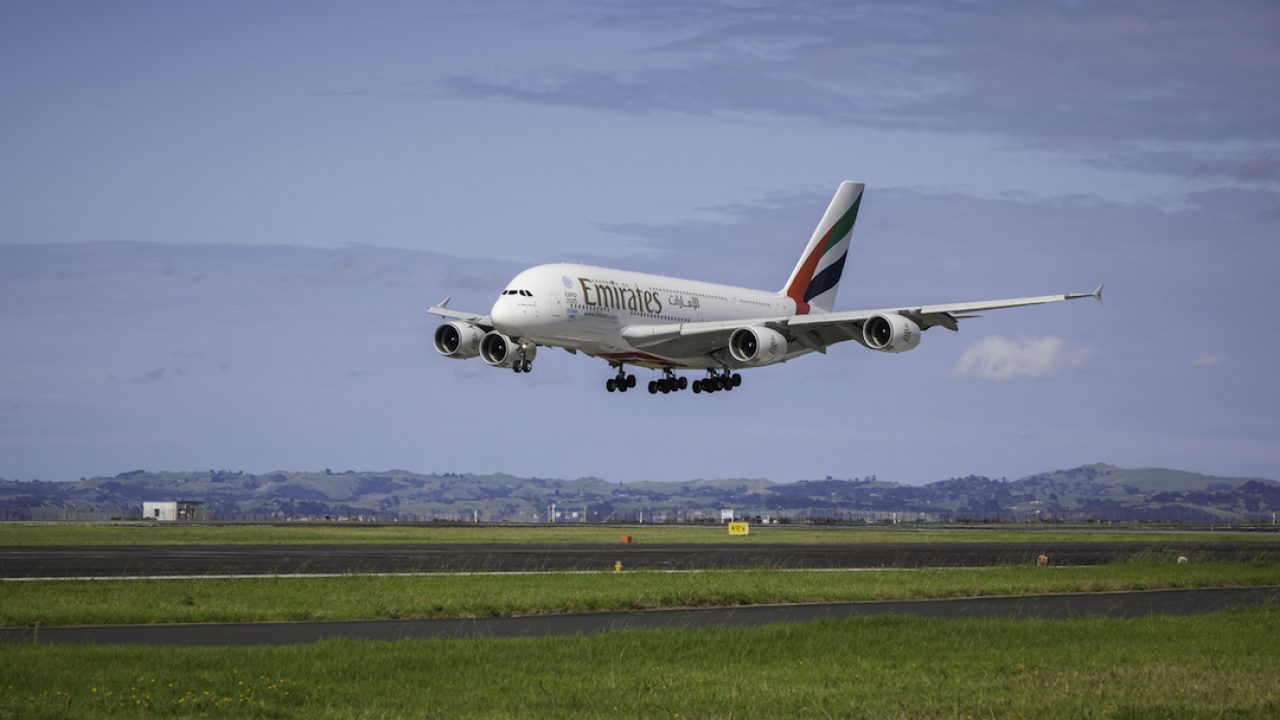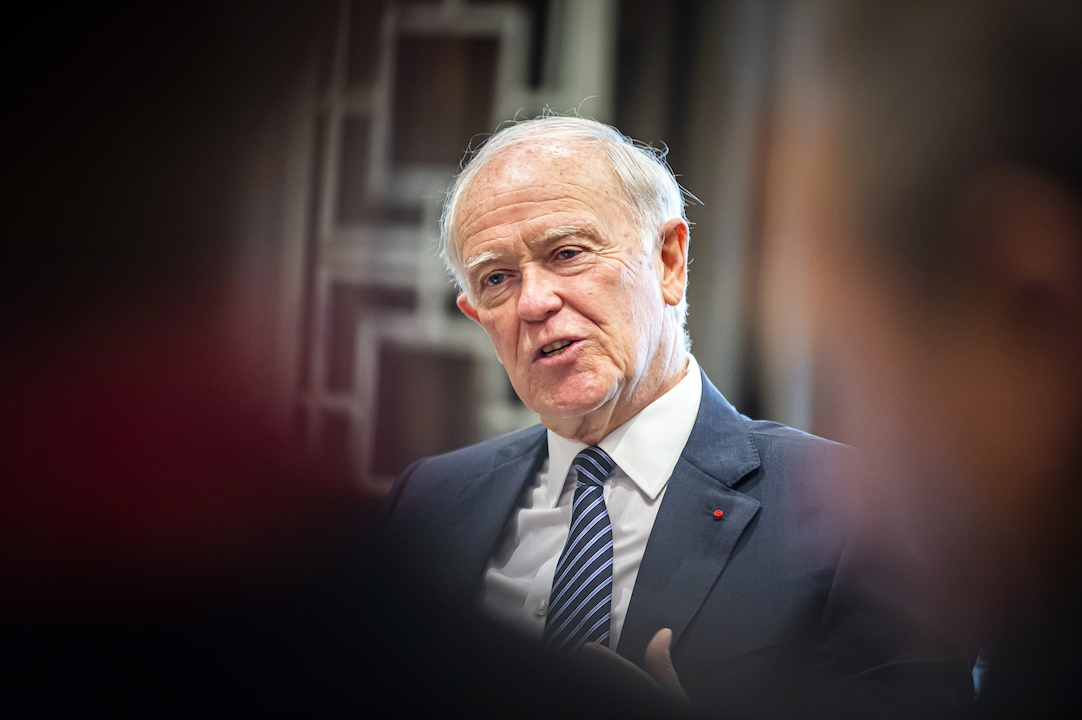Why Clark's tail is up
Emirates has always taken a firm hand to back its belief on demand and the airline’s president Sir Tim Clark explained to Paul Relman how despite supply chain frustration, the growth will go on.

Key role: Emirates will continue to operate the A380s until at least the late 2030s, but they could remain in service until early 2040s. Image: Emirates
Sir Tim Clark was in a feisty mood when he addressed the UK Aviation Club in London at the end of February. He pointed the finger at Airbus and Boeing for contributing to the supply-chain malaise, which is causing the ongoing delays to aircraft deliveries amid the struggle to increase production rates. He also expressed frustration around the much-delayed certification of the Boeing 777X and reiterated the need for Rolls-Royce to improve the durability of the Trent XWB engine on the A350-1000 if Emirates is to order it.
Overall, Clark is upbeat about the demand recovery as the airline sector powers back into its next growth cycle. “We never believed that demand would do anything other than bounce back with a significant robustness. Emirates was a ‘first mover’, we got our fleet armed and ready to go. We got the Airbus A380s etc flying as quickly as we could.
“Looking forward, we see no decline in any of our segments. We see real growth in some of the existing segments. In essence, as I look forward over the next 10-15 years - notwithstanding the geo-politics, the socio-economic stresses etc - one thing is coming through very clearly: that demand for air traffic remains very, very robust.”
The airline now has all but 22 of its 252 passenger airliners back in service, with 22 A380s still to be progressively reactivated through to early 2026. The Emirates cargo business also has 14 widebody freighters in service. During last November’s Dubai air show, Clark signed firm orders for another 110 Airbus and Boeing widebodies for delivery through to the mid-2030s. The deals comprised 55 Boeing 777-9s, 35 777-8s, five 787-10s and 15 A350-900s. The airline’s total backlog stands at 305 passenger widebodies, along with a further five freighters.
In terms of business recovery, Clark does not expect Emirates’ passenger numbers to fully recover to the pre-Covid highs of around 59 million annually during the current financial year (ending 31 March 2024), as the fleet is still not back to full strength. In its last fiscal year (to 31 March 2023), Emirates carried 44 million passengers.
“We’re not back to those [pre-Covid] passenger numbers, but we’re not far behind. When we get those A380s back in, we’ll push the numbers back up again,” he said.
After deliveries averaged around 20 passenger aircraft a year during the 2010s, shipments to Emirates have been flatlining since the pandemic. The 123rd and final Emirates A380 was received in December 2021 and the next passenger aircraft delivery to the airline is due in August when the first of 65 A350-900s will arrive.
Emirates should have begun receiving its Boeing 777-9 order in 2020, but a series of programme slips means deliveries are not expected until at least late 2025. The 777X series has suffered a series of delays to certification, largely due to increased regulatory scrutiny around Boeing and around approval of derivative aircraft in the wake of the two 737 Max tragedies. When asked about the latest delivery schedule Clark jokes “every day is a different day at Boeing … it could be the back end of next year, but more likely early 2026”.
Clark remains unconvinced by Boeing’s alternating schedule guidance: “Frankly, with what's being going on over there [at Boeing] and the FAA's increased surveillance and scrutiny of what they're doing, I'm beginning to doubt [the latest date] as well.”
To compensate for the 777-9 delay, Emirates has extended the use of its predecessor, the 777-300ER. Meanwhile, the A380 fleet will be coming back to full strength over the next two years. “We took the decision to kick in a $3 billion refurbishment programme for the 777s and A380s. We’re gutting the aeroplanes, rebuilding them with the latest products, so we can keep those going. That gives us the ability to maintain the network without having to worry about the foibles of deliveries not arriving on time.”
Emirates will continue to operate the A380s until at least the late 2030s, said Clark, but they could remain in service until early 2040s, subject to the supply of replacements.
Like many in the airline industry, Clark is unimpressed at the hash the OEMs and their supply chains have been making in building back production. “I got the impression on both sides of the Atlantic that they were asleep at the wheel” during the pandemic, he said. The airframe manufacturers were “passing messages that they didn’t think things were going to recover” before 2026-2028. That prompted both manufacturers during 2020 to “take the initiative to start shutting down… and seemed to be oblivious to the fact that the supply chains into them would also die a death - they didn’t have the capital robustness to be able to stay in business”.

Clark said the OEMs are now “reaping the whirlwind” of that situation, and “getting the supply chain back is taking an awful long time. There is no shortage of aircraft orders, but the difficulty is with the OEMs getting aircraft out the door.”
The current lack of fleet growth has been holding back Emirates’ expansion, said Clark. “There is so much more [we could fly]: South America, Africa, Asia… If I could just get another 50 per cent more aircraft in the air, I'd do it.”
Sales in another key market, China, are still down but Clark expects this to rebound sharply at some point, especially for leisure travel.
Clark said he is well accustomed to the rise of Emirates “imitators” around the region, the most recent being Saudi Arabia's Riyadh Air, which like Turkish Airlines, Qatar Airways and Etihad, looks set to adopt some Emirates’ best practice. While his general attitude is that there is “plenty of demand for all”, Clark concedes that “sometimes it’s kept me up at night. But in the end, I have a firm belief in what we can do. And the more noise there is about what we do, the easier I sleep in my bed.”
One notable absentee from the Emirates’ Dubai announcements was an order for the Rolls-Royce Trent XWB-97-powered A350-1000. Clark is clearly keen for what is now the largest Airbus widebody to join the fleet, having already created potential cabin layouts.
But he will not place an order until Rolls-Royce “gets the engine right” and makes the pricing “affordable”. Clark had made his position clear at the Dubai Air Show and said he was “deeply disappointed that we couldn’t have what we needed on that engine”. But Rolls-Royce CEO Tufan Erginbilgic has recently assured him that “something like £1 billion has been committed to sort the engine out”.
Clark’s beef is around the XWB-97’s durability and poor time-on-wing (TOW) performance in the Emirates operating environment. Derby has undertaken to double the TOW, but Clark said more improvement will be needed, claiming TOW is currently only “about 500 cycles” and the airline wants “about 2,500… so they’re not there yet”.
Clark said that while the aviation industry’s efforts to address sustainability are applaudable, “some realism” needs to be injected into the debate: “We have some pretty onerous and difficult targets to achieve ‘net-zero’ carbon emissions by 2050. It’s all very well to talk about SAF, but getting there is the biggest single problem – decarbonising the planet in the time that people want mankind to do that is going to be a herculean task.
“I fret that the airframe manufacturers are absolutely fixated on single-aisle and hydrogen [propulsion] – that’s not going to crack the problem. They’re not talking about the next generation of twin [aisle]. What you see today is what you’re going to get – A350-1000 on the right and on the left 787 and 777-9 - which will be the biggest aircraft flying. After that, nothing else.”
Emirates and sister carrier Flydubai are “bolted at the hip”, said Clark, and between them have created a “network that is one of the largest in the world”.
Flydubai announced its first widebody order at the Dubai air show last year with a deal for 30 787-9s for delivery from “2026-2027”. These will join the airline’s existing all-737 fleet and will be used to “go to places we wouldn’t”, said Clark.
Looking to the future, the airline faces two key decisions around timings: that of the move to Al-Maktoum International (Dubai World Central/DWC) airport and the succession of Clark at the Emirates’ helm.
Annual traffic at Dubai’s main airport DXB has reached 85 million passengers and Clark said that while there is theoretically a lot more headroom across the day, the airport will struggle to accommodate the airline’s daily operating peaks as frequencies and passenger numbers rise. So DWC will be central to Emirates future success, and a government decision around funding for the next phase of the new airport’s expansion is eagerly awaited.
Clark, who has been at the helm of Emirates since 2003, had been set to retire in 2020 until the Covid-19 crisis prompted an extension. The recent promotion of 19 senior executives included the appointment to new “deputy president” positions of two Emiratis long-tipped as potential Clark successors – chief operating officer Adel Al Redha and chief commercial officer Adnan Kazim.
“This round of promotions was preparation not for my departure, but for the airline for what I call the third epoch – believe me there’s an awful lot coming,” Clark said.
Stay up to date
Subscribe to the free Times Aerospace newsletter and receive the latest content every week. We'll never share your email address.

